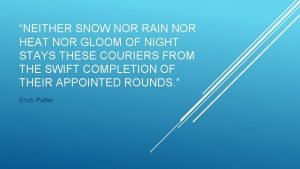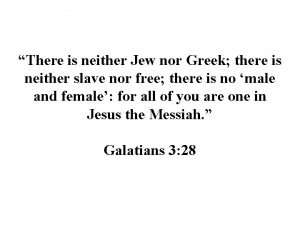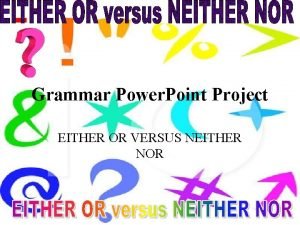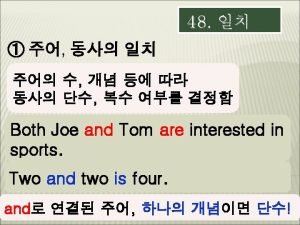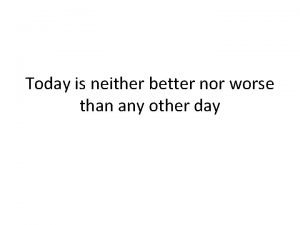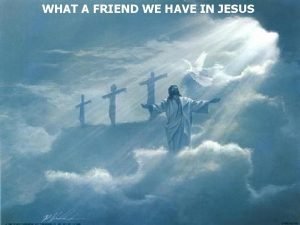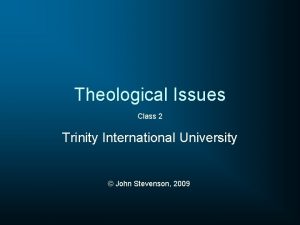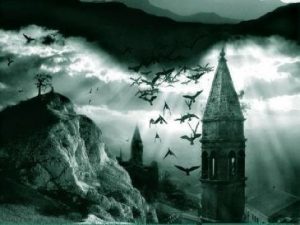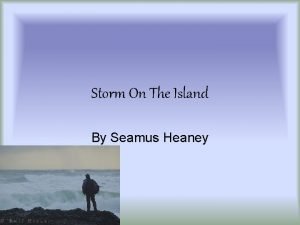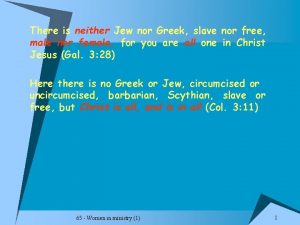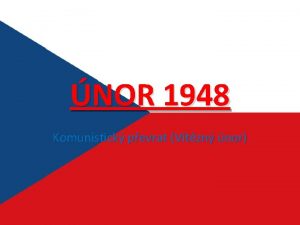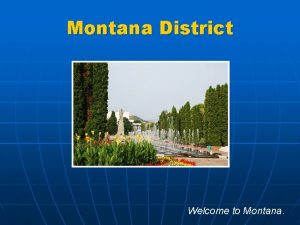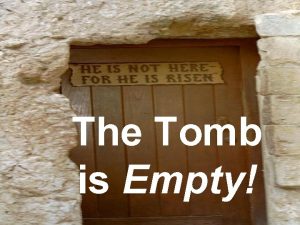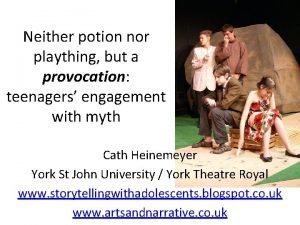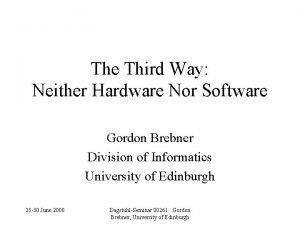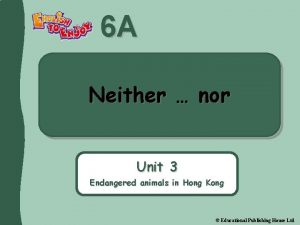An Introduction to Neither Empty nor Unknown Montana























- Slides: 23

An Introduction to Neither Empty nor Unknown: Montana at the Time of Lewis and Clark An exhibit of the Montana Historical Society

Indigenous Peoples… Are the original inhabitants of a region. Are not immigrants from a foreign land…or descendants of immigrants. Tribal histories reveal thousands of years of use and interaction with the Montana landscape.

When Lewis and Clark journeyed across “Montana” in 1805, they were traveling through the homelands of many different indigenous nations—not through an empty wilderness or an unknown land. Many of these tribes still reside in Montana— some on the same lands that their ancestors have inhabited for thousands of years.

Using the map legend above, you will be able to read the maps pictured in the following slides, locating each tribe’s original homeland along with the location of its additional tribal use area.

Northwestern Montana – Kootenai and Blackfeet The Kootenai (Ktunaxa) Nation’s ancient homelands extended from northwestern Montana into Idaho and British Columbia, overlapping to the east with those of the Blackfeet. The Kootenai language is unrelated to any other language in the world. The Blackfeet (Niitsitapi Pikuni) historically inhabited much of northern Montana and hunted as far south as the Yellowstone River. Their relatives lived, and continue to live, across the border in Canada.

Western Montana – Nez Perce, Shoshone, Pend d’Oreille, and Salish The heart of Nez Perce (Ni. Mi. Puu) and Shoshone (Akidika) tribal homelands lay to the west (in present-day Idaho), but both tribes hunted and traveled extensively in southwestern Montana. Shoshone cave paintings in central Montana indicate that this tribe once inhabited a larger territory here than it did in 1800. The Pend d’Oreille (Qlispé) and their allies, the Salish (Séliṡ) have lived in southwestern Montana for thousands of years. Both tribes frequently traveled east of the Rocky Mountains, where they hunted bison and clashed with the Blackfeet.

South-Central Montana – Crow, Cheyenne, and Sioux With its plentiful game, central Montana was a popular hunting, raiding, and trading ground among all of Montana’s tribes. After 1600, the Crow (Apsáalooke) tribe dominated the region from the Missouri River to the Bighorn Mountains, pushing the Shoshone west. They shared their eastern range with their relatives, the Hidatsa (Hiraacá). Their enemies, the Cheyenne (Tsetsêhesêstâhase/So’taahe) and Sioux (Lakota, Dakota) tribes, neighbored them to the southeast.

Northeastern Montana – Gros Ventre, Assiniboine, and Plains Cree North-central Montana is home to the Gros Ventre (A’aniniin) tribe, whose range overlapped with the Blackfeet to the west, the Crow to the south, and the Assiniboine and Cree tribes to the east. By the late 1600 s, the Assiniboine (Nakoda) and Plains Cree (Nehiyawak) bands extended their range into what is now northeast Montana. As the fur trade pushed westward in the mid-1700 s, Chip-pewa (Annishinabe and Metis) bands also moved into this region.

Extensive intertribal trade ensured the exchange of goods, people, and raw materials from one region to another. Tribes met to trade, intermarry, renew alliances, and share news.

Plateau Tribes Hunted and Fished The Kootenai, Salish, and Pend d’Oreille tribes traveled east over the Continental Divide to hunt bison during the summer and fall. However, like other tribes of the Columbia Plateau, they also fished for salmon and trout, which were plentiful west of the Rocky Mountains.

Seasonal Rounds Each tribe followed its own seasonal round— moving from place to place according to the natural resources available during different seasons of the year. Hunting, fishing, harvesting, trade, and ceremonies had their own proper time and place. Families might go their separate ways in summer, but come together again as a tribe in the fall for bison hunting.

Bison Cultures of the Plains East of the Rocky Mountains, bison formed the cornerstone of the economies and ways of life for Montana’s indigenous peoples. Plains tribes—like the Blackfeet, Crow, White Clay, and Lakota— depended on bison for food, shelter, tools, and many other aspects of their survival.

Today’s Indian reservations represent only a small fraction of the tribes’ original homelands. The reservations’ distance from one another confuses the reality of tribes’ historical interactions and shared hunting territories. Some indigenous nations who do not have reservations in Montana—such as the Nez Perce and Shoshone—retain their right to hunt here through treaties signed with the U. S. government. For all of Montana’s indigenous peoples, cultural and historical ties to these lands remain.

Shared Landscapes, Diverse Cultures • Each of Montana’s indigenous nations has its own language, unique history, and distinct customs, even though they share some cultural traditions. • By 1805, Montana’s tribes were already beginning to experience the influences of America’s westward expansion, but their cultures and way of life remained mostly intact until the 1850 s. • The exhibit, “Neither Empty Nor Unknown, ” provides a glimpse into the daily lives of Montana’s indigenous peoples before their lives and landscapes were forever changed by Euro. American settlement.

YOUR TOUR When you tour the exhibit, you will be learning more about traditional lifeways through stories from two Crow people— Plenty Coups and Pretty Shield—along with an original Blackfeet story.


Pretty Shield (1855 -1944) was a Crow woman who grew up during the buffalo days. During her childhood and early adulthood, the Crow tribe hunted bison, moved among seasonal camps, gathered roots and berries, and traded with and raided other tribal nations. Her stories are important today because they tell of a time before white Americans came to the West and forever changed the ways of life, economies, and cultures of indigenous peoples.

Plenty Coups (1848 -1932) was a prominent Crow leader. He saw the transition from the buffalo days to the early reservation years. During his lifetime, and still today, Plenty Coups was/is regarded as one of the greatest Crow chiefs ever. He was a skilled hunter, warrior, leader, and diplomat. His home is now a state park in Pryor, Montana, that you can visit to learn more about this great man and his people.

Even in his old age, Plenty Coups worked hard to protect his people and their way of life and made several trips to Washington, D. C. , to speak on their behalf. He had no children of his own, but regarded all Crow people as his children.

Historically, the Blackfeet and Crow tribes were enemies and often raided one another’s hunting camps between the Missouri and Yellowstone Rivers.

All of the stories we hear have been preserved in the oral traditions of the tellers’ tribes or were written down as they were told to other writers.

“How did indigenous people live before non-Indian settlers moved into what is now Montana”? • That is our essential question. We will find answers through: – Artifacts (objects) indigenous people used. – Stories from the lives of Pretty Shield, Plenty Coups, and others.

Additional resource: Introducing the First Nations of Montana to the World (video). Montana Department of Tourism, 2012. https: //vimeo. com/49771618 Contact the Montana Historical Society to schedule school-group tours: call (406) 444 -4794 or email mhs. Education@mt. gov This Power. Point and accompanying lesson plans were created by Laura Ferguson for the Montana Historical Society, © 2016.
 Angareion
Angareion Is 1 prime composite or neither
Is 1 prime composite or neither Shakespeare education school
Shakespeare education school Neither jew nor greek
Neither jew nor greek So too either neither exercises
So too either neither exercises Either or vs neither nor
Either or vs neither nor No a nor b
No a nor b Asymptote that is neither horizontal nor vertical
Asymptote that is neither horizontal nor vertical Inversion neither nor
Inversion neither nor If n = m then y = 0
If n = m then y = 0 Asymptote that is neither horizontal nor vertical
Asymptote that is neither horizontal nor vertical Neither better nor worse
Neither better nor worse Dlc protocol
Dlc protocol Nor death nor principalities
Nor death nor principalities Nor death nor principalities
Nor death nor principalities Nor death nor principalities
Nor death nor principalities Which fits best in the empty box above?
Which fits best in the empty box above? The cask of amontillado short story analysis answers
The cask of amontillado short story analysis answers Spits like a tame cat turned savage
Spits like a tame cat turned savage Labelled skin diagram
Labelled skin diagram Empty-can test
Empty-can test Joint set symbol
Joint set symbol Empty hair follicle
Empty hair follicle Prolog list of lists
Prolog list of lists
